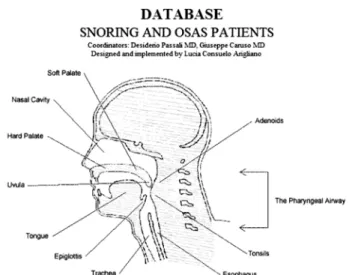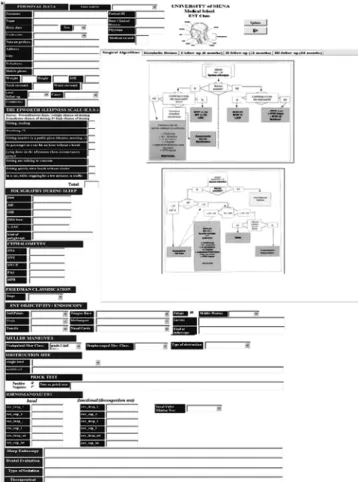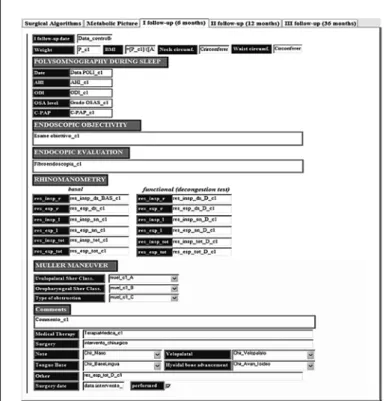252
ACTA oTorhinolAryngologiCA iTAliCA 2012;32:252-255
Sleep disorders
Database application for patients with obstructive
sleep apnoea syndrome
Applicazione di database per i pazienti affetti da OSAS
D. Passali, G. Caruso, l.C. ariGliano, F.M. Passali1, l. BellussienT Department, università di siena; 1 enT Department, università di roma “Tor Vergata”
SummAry
obstructive sleep apnoea syndrome (oSAS) results from upper airway collapse during sleep. it represents an increasingly recognized pa-thology associated with many diseases. herein, we describe a database for patients with oSAS. This has different goals: to facilitate good uniformity in clinical assessment, to allow the use of the application even by non-EnT specialists, to evaluate the results of medical and/or surgical treatments and to enable a statistical meta-analysis derived from the data collected in many oSAS medical centres.
KEy wordS: OSA • OSAS • Database • Software • Statistics
riASSunTo
La Sindrome delle Apnee Ostruttive del Sonno (OSAS), risultato del collasso delle strutture delle vie aeree superiori durante il sonno, rappresenta una patologia ormai ben definita, in continuo aumento a cui si associano molti altri disturbi e/o patologie. Lo scopo del seguente lavoro è quello di descrivere l’applicazione di un database per i pazienti affetti da Sindrome delle Apnee Ostruttive del Sonno. Gli obbiettivi sono pertanto di: facilitare una buona uniformità della valutazione clinica, per consentire l’utilizzo dell’applicazione anche dai non specialisti in Otorinolaringoiatria, di valutare in maniera obbiettiva e sistematica i risultati dei trattamenti medici e/o chirurgici e di avviare una meta-analisi statistica costruita sulla base delle informazioni recuperate dai dati raccolti nei centri medici OSAS che lo utilizzeranno.
pArolE ChiAvE: OSA • OSAS • Cartella clinica informatizzata
Acta Otorhinolaryngol Ital 2012;32:252-255
Introduction
obstructive sleep apnoea (oSA) is characterized by re-current episodes (≥ 5/h) of apnoea or hypopnoea caused by partial or complete obstruction of the upper airways (uA). From an epidemiological point of view, its inci-dence is estimated to be 2% in women and 4% in men. This means that in italy about 623,200 women and about 1,169,100 men are affected by oSA. however, oSA rep-resents a major problem not only for its social impact, but also from a general health point of view. There is a recog-nized association between oSA and metabolic syndrome,
designated syndrome Z 1. it is now widely accepted that
this pathology has a multifactorial aetiology, and hence must be treated with a multidisciplinary approach. Since 2002, at the EnT unit of the university of Siena, an outpatient Clinic for oSA surgery has been function-ing where patients are referred by general practitioners or non-EnT specialists such as the neurologists, pneumolo-gists, endocrinologists and cardiologists.
At the very beginning, the implementation of a database (dB) exclusively devoted to oSAS was suggested by the need to collect the patient information (personal data, clinical
investigations) and to record surgical follow-up. Afterwards, it was decided to develop a tool that was also useful for other specialists, that would store data, automatically calculate se-lected indexes and extract homogeneous data for subsequent statistical analysis. This compelled the programmer to create not just a simple desktop dB, but a genuine dB application. herein, the oSAS dB application is described.
Materials and methods
The dB was implemented using the microsoft Access database application for windows (2002-2003 version and 2007 version) 2-6, which allows storing, managing,
importing or linking data (even stored in other applica-tions or databases). The numerous and simple tools sup-plied by Access were integrated with more sophisticated programming languages, as for example the Structured
Query language (SQl) 7 8 and visual Basic for
Appli-cations (vBA) 9 10. The main objective was to design
a dB application which, automating all the operations employed to manage a dB, turns a complex set of in-structions and commands into simple operations that are approachable even by inexperienced users.
oSAS database
253
Results
The main form of the dB was designed taking into considera-tion the wide spectrum of data and also the necessity to offer an intuitive and simple tool. it consists of three sections: • the first dedicated to manage the available information
(inserting, updating and extracting data); • the second to consult data of individual patients; • the third for programming and scheduling surgery. in this way, the primary (to facilitate a good uniformity of clinical assessment) and secondary outcomes (to evalu-ate the results of medical and/or surgical treatment and to enable a statistical meta-analysis of data collected from different centres) could be easily attained.
Discussion
A dB is a structured and ordered collection of information closely related to each other, stored on a mass storage de-vice (e.g. hard disk), organized to store, manage, update and retrieve large amounts of data. when these data operations are automated by programming, so as to turn a complex set of instructions and commands into simple actions perform-able even by inexperienced users, a sophisticated type of dB, called “dB application”, is obtained. The project named “oSAS patient” is a dB application that was implemented us-ing microsoft® Office Access software for Windows. Specific
for the management of the relational dB, Access was chosen in the 2002-2003 version because it is widely available and for the fact that provides, among others, tools such as: • Referential Integrity;
• Active Data Object (ADO); • Structured Query Language (SQL); • Visual Basic for Applications (VBA); • Object Linking and Embedding (OLE); • Automatic Data Processing (ADP).
The dB Application “oSAS patient”, in fact, was de-signed and implemented to meet not only the initial objec-tives of the project, but also those that became necessary during its development.
opening the application launches a sagittal section of the head and neck (Fig. 1). This initial screen was designed to remind the non-EnT specialists involved in the diagnos-tic-therapeutic process that oSAS is a disease strongly as-sociated with upper airway patency, and hence the otorhi-nolaryngologist’s evaluation is an indispensable step. By clicking on this image, the main form opens (Fig. 2), which is divided into three sections. The first section al-lows accessing the patient’s personal information and in-vestigations necessary for clinical assessment; in addition, it offers the possibility to extract all information concern-ing the patient in Excel format. The second and third sec-tions of the form are conceptually equivalent: both allow retrieving the data through a so-called “report”. A report, in fact, shows selected records in a user-designed for-mat (predefined by the programmer in response to user’s
needs) and allows printing data streams, extracted from one or more forms or queries. in our case, there are two types of reports: those dedicated to the patient (clinical history, first follow-up, etc.) and those to the planning of surgical interventions (surgeries selected by date, etc.) By clicking on the icon “insert and up-to-date patient data”, it is possible to access the area reserved to personal data of the patient and his/her clinical-instrumental evaluation (Fig. 3). The user is supplied with several tools to enter, update and store information, but also to link each record to an exter-nal file, such as for example, a medical record. The first clinical data evaluated are weight and height of the patient, Bmi (automatically calculated by the application) and neck and waist circumference. it is well known, in fact,
that obesity is the major risk factor for oSAS 11. in
sub-jects with Bmi > 30, the incidence of sleep apnoea reaches 40-60%, and circumference of the neck is the parameter
that best correlates to obesity oSAS 12. As mnemonic help,
by positioning the mouse on the corresponding field, the measures considered pathological are suggested. Also, for the Epworth Sleepiness Scale (ESS), it is easy to read that
a score > 10 is considered pathologic 13. next,
polysom-nographic data and cephalometric values can be entered.
Fig. 1. Sagittal section of the head and neck: start-up form of the DB.
d. passali et al.
254
For the latter, only some parameters were implemented, in particular, we reported the analysis of the Stanford group: SnA, SnB, Snp-p, mp-h. Also for these parameters, the application automatically suggests the standard value (a deviation of ± 2 represents the range of normality). Endoscopic examination with muller manoeuvre offers a detailed description of the various sites of the uA and the possibility to enter the different levels and types of ob-struction according to the Sher classification 14 15.
Along-side these data, Friedman staging 16 can be entered as well
as the mallampati score. nasal evaluation may be com-pleted by the results of skin prick tests and rhinomanom-etry. The most recent literature confirms the importance of a complete nasal evaluation, considering that the com-bination of high mallampati score and nasal obstruction represents a greater risk factor for worsening of oSA as well as a predisposing factor for oSAS 17 18.
Finally, a field dedicated to sleep endoscopy, if carried out, is available. There is also a free field to enter data for dental evaluation. As a further help, in the middle part of this form, the slightly modified surgical algorithms suggested in the
“guidelines in EnT oSA Surgery” 19 were embedded.
Clinical assessment, oSA staging, nasal evaluation and the possibility to follow widely accepted surgical algo-rithms should ensure uniformity in the diagnostic-thera-peutic process.
The patient form is then completed by considerations on
therapeutic planning and by four dedicated pages: the first to metabolic assessment (Fig. 4) and the last three to fol-low up (Fig. 5). These pages were included to reach several goals. One of the first objectives of the DB, in fact, was to improve quality and uniformity of the diagnostic process in the italian medical centers involved in oSAS; another goal is to have an useful tool not only for the EnT specialists, but also for other specialists who deal with oSAS. Thus, the metabolic form was included, which allows storage of routine blood tests, ECg evaluation, holter trace, some hormones such as leptin and ghrelin, and the dosage of the inflammatory cytokines such as il-1β, il-6 and TnF-α. As it is now well known, sleep loss is associated with a dysregulation of neuroendocrine control of appetite with a reduction of the satiety factor, leptin, and an increase in the
hunger-promoting hormone ghrelin 20. Finally, the
follow-up consists of three clinical controls at 6, 12 and 36 months. A correct evaluation to define success of various surgical procedures, in fact, should provide a follow-up that is not limited to just 6 months, but extended to 36 months. At each control visit, the same clinical-instrumental tests ap-plied during the first observation are repeated.
in compliance with privacy laws, the dB is protected by password.
Finally, from a statistical point of view, a very structured analysis has been already designed. The possibility, in fact, to easily convert data stored in Access to Excel for-mat (see the Excel icon in Fig. 2), will supply not only a large amount of data but also homogeneous information. Even from several oSAS centres, the method used to col-lect the data allows overcoming some of the recognized problems of retrospective meta-analyses.
The dB application has been registered with copyright number dEp634353565069085969.
Fig. 3. Area for personal data and clinical-instrumental evaluation.
oSAS database
255
Conclusions
The main objective in designing the dB presented here was to supply EnT Specialists and other colleagues involved in the therapeutic and diagnostic process of oSAS with a very simple and intuitive tool. despite the ease of use, this dB application goes far beyond the simple storage of the patient data and surgical/therapeutic follow-up.
The expected effects from distributing the dB are a more ho-mogeneous behaviour in diagnostic planning; improvement of diagnostic accuracy; an increased collaboration among the specialists for health and research; rationalize costs linked to diagnosis; and finally, the possibility to collect data for ho-mogeneous and consistency statistical analysis.
For the treatment of oSAS, a multidisciplinary approach is needed to best serve the health and quality of life of these patients. A DB application specifically dedicated to oSAS can offer a vigorous contribution.
Acknowledgements
Thanks to the italian orl Society oSAS Study group (m. de Benedetto, d. passali, A. Serra, g. Sorrenti, C. vi-cini) for all the support provided.
References
1 Carneiro g, Fontes Fh, Togeiro Sm. Metabolic
consequenc-es of untreated obstructive sleep apnea syndrome. J Bras pneumol 2010;36:43-6.
2 Feddema h. Microsoft Access Version 2002 Inside Out. mi-crosoft press; 2002.
3 Salvaggio A. Access: Programmazione VBA. milano: FAg; 2005.
4 viescas Jl. Maschere con Access. milano: mondadori infor-matica; 2005
5 macdonald m. Access 2007: The Missing Manual. o’reilly media; 2006.
6 viescas Jl, Conrad J. Microsoft Office Access 2007 Inside
Out. microsoft press; 2007.
7 viescas Jl. Query con Access. mondadori informatica; 2005. 8 Ferrero m. Laboratorio di SQL. milan: Apogeo; 2002. 9 viescas Jl. Report con Access. mondadori informatica; 2005. 10 Feddema h. Access 2007 TM VBA Bible For Data-Centric
Microsoft Applications. wiley; 2007.
11 Chin K. Sleep apnea syndrome and obesity hypoventilation
syndrome. nippon rinsho 2009;67:350-5.
12 Acıoğlu E, yiğit o, volkan Sunter A, et al. Obesity and
ob-structive sleep apnea syndrome. J otolaryngol head neck Surg 2010;39:744-51.
13 Collop nA, Anderson wm, Boehlecke B, et al. Clinical
guide-lines for the use of unattended portable monitors in the diagno-sis of obstructive sleep apnea in adult patients. Portable Moni-toring Task Force of the American Academy of Sleep Medicine. J Clin Sleep med 2007;3:737-47.
14 Sher AE, Thorpy mj, Shprintzen rJ, et al. Predictive value
of Müller maneuver in selection of patients for uvulopalat-opharyngoplasty. laryngoscope 1985;95:1483-7.
15 Sher AE. Obstructive sleep apnea syndrome: a complex
disorder of the upper airway. otolaryngol Clin north Am 1990;23:593-608.
16 Friedman m, ibrahim h, Joseph nJ. Staging of obstructive
sleep apnea/hypopnea syndrome: a guide to appropriate treatment. laryngoscope 2004;114:454-9.
17 rodrigues mm, dibbern rS, goulart Cw. Nasal obstruction
and high Mallampati score as risk factors for Obstructive Sleep Apnea. Braz J otorhinolaryngol 2010;76:596-9. 18 Zhu h, Feng y, Zhao C. The impact of nasal obstruction on
OSAHS. lin Chung Er Bi yan hou Tou Jing wai Ke Za Zhi
2010;24:547-8.
19 vicini C. Linee Guida in Roncochirurgia ORL. Argomenti di Acta otorhinolaryngologica italica 2007;1:29-54.
20 Knutson Kl, van Cauter E. Association between sleep loss
and increased risk of obesity and diabetes. Ann ny Acad Sci 2008;1129:287-304.
Fig. 5. Follow-up form.
received: September 6, 2011 - Accepted: december 12, 2011
Address for correspondence: desiderio passàli, EnT Clinic uni-versity of Siena, via Anagnina 718, 00118 rome, italy. Tel. +39 335 6102667. Fax +39 06 79844154. E-mail: [email protected], [email protected]


